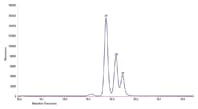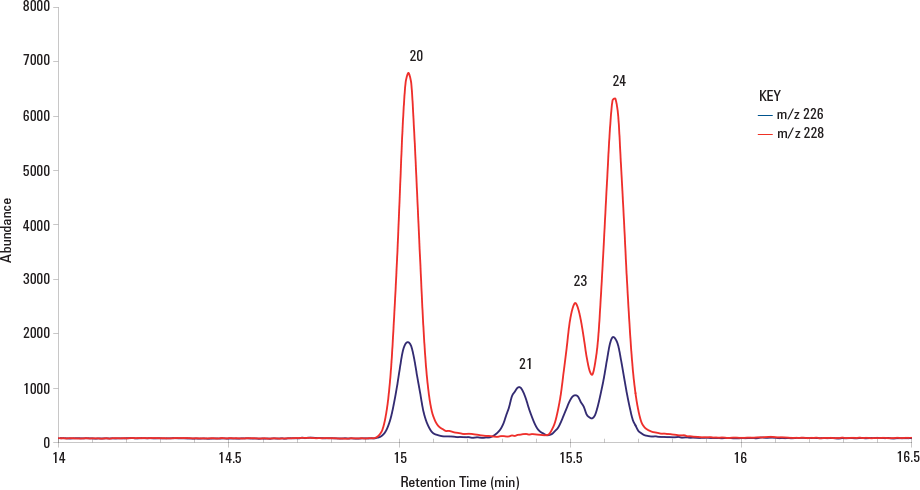Access Agilent eNewsletter September 2015
>> Update My Profile | Subscribe to Access Agilent | Article Directory

Agilent GC columns help to safeguard foods with fast, accurate analysis of PAHs
By Laura Provoost
Agilent Product Manager – GC Columns
Polycyclic aromatic hydrocarbons (PAHs) are a large group of compounds known to cause cancer. They may occur in food by uptake from the environment or generated during food processing. Because some PAHs are carcinogenic and mutagenic, the scope of regulated PAHs is under constant review. Changes to regulations set the need for quantification and separation of PAHs not previously monitored.
Benzo[a]pyrene was thought to be a suitable marker for the occurrence of carcinogenic PAHs in food and until recently was the only one regulated. Now, the combination of benzo[a]pyrene, chrysene, benz[a]anthracene, and benz[b]fluoranthene (PAH4) is recommended by the European Food Safety Authority as a suitable indicator.
The accurate quantification of US EPA or EU priority (15+1) PAHs requires the separation of the individual PAHs via mass ion spectrometry or chromatography, or both. For GC/MS analysis, some co-eluting PAHs exhibit an identical MS fragmentation pattern. Therefore, to obtain unambiguous identification and more accurate quantification, optimized capillary column selectivity and dedicated liquid phase chemistry are essential.
To address this evolving regulatory environment, let’s examine a couple of examples, highlighting GC/MS with the Agilent J&W Select PAH GC column for the analysis of PAHs in foods. This innovative and high-selectivity stationary phase delivers accurate analysis of PAHs. Select PAH is a single solution that separates all relevant isomers, thereby avoiding false positives and inaccurate results.
 Enlarge
Enlarge
Figure 1. Separation of benz[a]anthracene (20), cyclopenta[c,d]pyrene (21), chrysene (24) and interfering triphenylene (23), m/z 226 (blue), m/z 228 (red).
 Enlarge
Enlarge
Figure 2. Separation of benzo[b]fluoranthene (27), benzo[k]fluoranthene (28), benzo[j]fluoranthene (29), m/z 252.
Agilent J&W Select GC column identifies and measures PAHs in salmon
We first looked at PAHs in salmon, using the Agilent J&W Select PAH GC column for GC/MS in SIM mode. The sample used was a certified material that was additionally spiked with EU priority PAHs, as well as triphenylene as an important interference. The PAH concentration range varied from 1 to 7 ppb.
Some PAHs have identical mass fragmentation and are also difficult to separate on most GC columns. These PAH pairings are:
- Benzo[b]fluoranthene (BbF), benzo[k]fluoranthene (BkF), benzo[j]fluoranthene (BjF), (Mw 252)
- Chrysene (CHR), triphenylene (TR), benz[a]anthracene (BaA), cyclopenta[c,d]pyrene (CPP), (Mw 226, 228)
- Indeno[1,2,3-cd]pyrene (IcP), benzo[b]triphenylene (BtP), dibenzo[a,h]anthracene (DhA), (Mw 276,278)
- Benzo[b]fluorene (BbF) and benzo[c]fluorene (BcF), (Mw 216)
Figures 1 and 2 illustrate the excellent separation that can be obtained on the Select PAH column for the four critical peak pairs. The 50% valley separation between triphenylene and chrysene allows unambiguous quantification of chrysene (Figure 1), included in the EU priority PAH, as well as in PAH4.
In Figure 2, we see how benz[a]anthracene (Mw 228) is adequately isolated from interfering masses. At the same time, achieving an optimal separation of benzo[b]fluoranthene, benzo[k]fluoranthene and benzo[j]fluoranthene.
The combined separation of chrysene/triphenylene and the three benzofluoranthene isomers is a unique feature of the Agilent J&W Select PAH GC column. The column also elutes the high molecular weight dibenzopyrenes as sharp peaks with low column background and good signal-to-noise.
Full details of this analysis are freely available in Agilent publication SI-02424. The full note illustrates the possibilities offered by Select PAH for more accurate reporting of PAHs, including all (15+1) EU and 16 US EPA priority PAHs, as well as interfering isomers for a salmon matrix in a 30 min GC/MS analysis.
 Enlarge
Enlarge
Figure 3. Overlay of milk chocolate extract (black trace) matrix with PAH standards (red trace) showing good response at 10 ppb with the last components having no interfering ions. The column was the Agilent J&W Select PAH, 15 m x 0.15 mm, 0.10 µm film.
Quick, easy detection of PAHs in chocolate
It is well established that grilling over an open flame will introduce PAHs to many foods. Roasting processes, such as those used for cocoa beans and peanuts, offer other means for introducing PAHs. However, separation of trace ppb levels from these matrices can be challenging and time consuming. Nonetheless, it is perfectly possible to extract and analyze samples for PAHs even though the sample cleanup for GC/MS is less than ideal. The Agilent J&W Select PAH GC column, along with an optimized temperature program, separates PAH isomers and provides the shortest overall assay time (Figure 3). Run times are about 60 minutes with complete elution of all PAHs in 30 minutes. Column bakeout of co-extracted cocoa butter triglycerides requires another 30 minutes.
To preserve GC column lifetime, we recommend using an Agilent Ultra Inert liner with wool to collect nonvolatiles from the extracts.
The Agilent J&W Select PAH GC column, with an optimized temperature program, provides satisfactory separation of PAH isomers to meet regulatory requirements. By virtue of being only 15 m long, it also delivers a reasonable bakeout time between runs for real-world sample extracts, including high triglyceride milk chocolate and oil-roasted peanuts.
Improve PAH workflows with Agilent solutions
You can learn more about the experiments described in this article by reading Agilent publications SI-02451 and 5991-2299EN. Look to Agilent for a wide range of instruments, columns, and supplies to improve chromatographic performance and facilitate quantitation of PAHs in foods. These complete workflow solutions include sample prep, analysis, and data reporting tools. Our portfolio of products and preconfigured analytical solutions can help your laboratory maximize sample throughput, while maintaining optimal analytical performance. Explore the whole range to see how Agilent solutions can help your work in safeguarding the health of our food.
>> Update My Profile | Subscribe to Access Agilent | Article Directory


